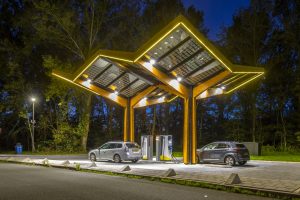The push to reduce greenhouse gas emissions has driven the commercial vehicle sector, including medium and heavy-duty trucks, buses, and delivery vans, toward electrification. According to BloombergNEF’s Electric Vehicle Outlook 2024, the global electric truck market is projected to grow at an annual rate of 28%, with electric delivery vans and short-haul trucks leading the transition. Amazon, UPS, and FedEx have already begun electrifying their fleets to meet sustainability targets and reduce operational costs.
Despite growing interest in electric cars, the lack of adequate charging infrastructure remains a significant obstacle. Unlike passenger electric vehicles, which can rely on widespread public charging networks, commercial vehicles require specialized, high-capacity charging solutions that cater to their larger battery capacities, longer operational hours, and higher energy demands.
The Primary Charging Model
In the commercial vehicle sector, depot charging is the dominant charging method. Fleets use this method when they have overnight or idle hours to charge vehicles at company-owned facilities. According to a 2023 report from the National Renewable Energy Laboratory (NREL), over 85% of electric vehicle charging occurs at depot stations. This allows for predictable charging cycles and minimal downtime. However, the method does have some shortcomings: the reduced range and flexibility of the vehicles make it unsuitable for long-haul operations.
Public EV charging infrastructure, primarily designed for passenger vehicles, lacks the capacity and design to accommodate heavy-duty electric trucks. A 2023 analysis by the International Council on Clean Transportation (ICCT) found that fewer than 5% of public charging stations in the United States can support heavy-duty vehicles, resulting in “charging deserts” along key freight corridors. The availability of high-powered direct current (DC) fast chargers, capable of delivering 350 kW or more, is crucial for long-haul electric trucks; however, it remains sparse and unevenly distributed across major transportation routes.
The Promise of Megawatt Charging Systems (MCS)
The introduction of Megawatt Charging Systems (MCS) is expected to revolutionize CV charging infrastructure. Capable of delivering up to 3.75 MW of power, MCS can fully charge a Class 8 electric truck in less than 30 minutes. Finalized by CharIN (Charging Interface Initiative) in 2024, MCS technology is poised to address the long-haul trucking industry’s need for rapid recharging. However, widespread commercial deployment remains a few years away.
Key Challenges Facing CV Charging Infrastructure
High-capacity charging places immense stress on the electric grid. A single megawatt charger can consume as much energy as a small town, raising concerns about grid resilience and power distribution. Without substantial grid upgrades and advanced load management systems, the widespread adoption of electric CVs could exacerbate grid congestion and reliability issues.
The uneven geographic distribution of charging infrastructure poses another significant challenge. A 2023 study by the American Transportation Research Institute (ATRI) revealed that over 60% of key freight routes in the United States lack sufficient high-capacity charging stations, leaving vast stretches of critical transportation corridors underserved. This lack of coverage creates operational challenges for long-haul electric trucks and hampers the broader electrification of the freight industry.
High Costs and Uncertain ROI
Establishing high-powered CV charging stations is capital-intensive, with installation costs ranging from $500,000 to over $1 million per station, depending on site requirements and grid upgrades. Moreover, maintenance and operational costs add to the financial burden. Fleet operators and infrastructure providers often hesitate to make such investments without guarantees of high utilization rates and favorable returns on investment (ROI), creating a bottleneck for infrastructure expansion.
Government Policies and Incentives Driving Growth
Recognizing these challenges, governments worldwide are implementing policies and funding programs to accelerate the deployment of charging infrastructure for electric vehicles.
- United States: The Bipartisan Infrastructure Law (2021) allocates $7.5 billion to expand electric vehicle (EV) charging networks, with a focus on underserved communities and major freight corridors. Additionally, the National Electric Vehicle Infrastructure (NEVI) Formula Program mandates that a portion of these funds be allocated toward high-capacity charging infrastructure for medium and heavy-duty vehicles.
- European Union: The Alternative Fuels Infrastructure Regulation (AFIR), adopted in 2023, requires member states to ensure that high-powered EV charging stations for heavy-duty vehicles are available every 60 kilometers along major transport corridors by 2030.
- China: China’s Ministry of Transport has set ambitious targets to install at least 2,000 high-powered charging stations along the country’s national highway network by 2025, supporting the electrification of commercial freight operations.
Innovations Shaping the Future of CV Charging Infrastructure
Vehicle-to-Grid (V2G) technology has the potential to transform electric trucks into energy assets that discharge excess power back to the grid during periods of peak demand. A 2024 pilot project conducted by the California Energy Commission demonstrated that V2G-enabled electric trucks could provide up to 1 MW of power to the grid, improving grid stability while creating revenue opportunities for fleet operators.
- Wireless and Automated Charging
Wireless inductive charging and robotic automated charging solutions are emerging technologies poised to enhance operational efficiency in fleet management. These technologies aim to minimize human intervention and streamline depot charging operations, although they are still in the early stages of development.
Bridging the Infrastructure Gap
The future of charging infrastructure for electric vehicles (EVs) requires a collaborative effort among policymakers, utilities, fleet operators, and technology providers. While government incentives and regulatory mandates are crucial in driving initial deployment, long-term sustainability will depend on public-private partnerships, grid modernization, and ongoing investment in high-capacity charging hubs.
As the transportation industry shifts toward electrification, addressing the infrastructure gaps for CV charging will be paramount to achieving global decarbonization goals. With advancements in charging technologies and growing policy support, the electrification of the commercial vehicle sector is within reach; however, sustained investment and innovation are necessary to overcome existing challenges.



